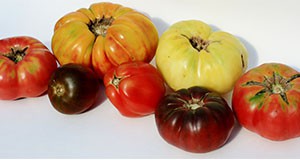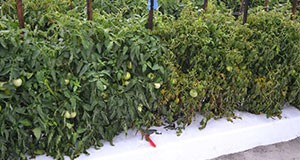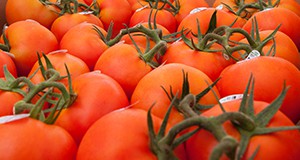CRISPR is a contemporary biological technology that has attracted the interest of both the science community and the general public. This 4-page article discusses why tomato researchers are interested in CRISPR, what tomato traits have been targeted by CRISPR, and potential applications of CRISPR for tomato genetics and breeding. Written by Tong Geon Lee and published by the UF/IFAS Department of Horticultural Sciences, February 2018.
http://edis.ifas.ufl.edu/hs1314
Tag: Tomato Varieties
Tomato Cultivar Selection Considerations for Open-Field and Protected Culture in North Florida

Tomatoes represent one of the most popular vegetables grown in protected culture such as greenhouses, high tunnels, or shade houses. Selecting the correct cultivar of tomato is critical and varies depending on the intended season, type of protected structure, training system, expected insect and disease pressure, post-harvest handling techniques, and intended market. This seven-page fact sheet will focus on the key factors affecting the cultivar selection decisions for growing and selling tomatoes in north Florida. Written by Blake R. Thaxton and Robert C. Hochmuth, and published by the Horticultural Sciences Department.
http://edis.ifas.ufl.edu/hs1273
The Good, the Bad, and the Ugly: What the Future Could Hold for Bs2 Tomatoes
 Bs2 tomatoes are transgenic tomatoes that have been engineered to contain the Bs2 gene from pepper. As such, they are considered a genetically modified (GM) food, or a genetically modified organism (GMO). Numerous trials conducted by University of Florida researchers have shown the benefits of these cultivars for bacterial spot disease management, and growers and industry members recognize the potential for Bs2 tomatoes to make Florida tomato production more sustainable. This 4-page fact sheet discusses the benefits that might be realized by the adoption of Bs2 tomato varieties, and the challenges standing in the way of their commercial production. Written by S. F. Hutton, J. W. Scott, J. B. Jones, R. E. Stall, G. E. Vallad, B. J. Staskawicz, and D. M. Horvath , and published by the UF Department of Horticultural Sciences, April 2015.
Bs2 tomatoes are transgenic tomatoes that have been engineered to contain the Bs2 gene from pepper. As such, they are considered a genetically modified (GM) food, or a genetically modified organism (GMO). Numerous trials conducted by University of Florida researchers have shown the benefits of these cultivars for bacterial spot disease management, and growers and industry members recognize the potential for Bs2 tomatoes to make Florida tomato production more sustainable. This 4-page fact sheet discusses the benefits that might be realized by the adoption of Bs2 tomato varieties, and the challenges standing in the way of their commercial production. Written by S. F. Hutton, J. W. Scott, J. B. Jones, R. E. Stall, G. E. Vallad, B. J. Staskawicz, and D. M. Horvath , and published by the UF Department of Horticultural Sciences, April 2015.
http://edis.ifas.ufl.edu/hs1259
Growing Heirloom Tomato Varieties in Southwest Florida (HS921/HS174)
Heirloom tomatoes have seen a rebirth in popularity because of increasing demand for fresh, fully ripe, tasty tomatoes. A tomato must meet three criteria to be considered an heirloom variety: The variety must be reproduced by seed, must have been cultivated for more than 50 years, and must have a history. Heirloom tomatoes are known for their singular taste, shape, and color, which include purple, orange, and yellow, in addition to the common red tomatoes. This 9-page fact sheet was written by Monica Ozores-Hampton, Charles S. Vavrina, and Aline Coelho Frasca, and published by the UF Department of Horticultural Sciences, February 2012.
http://edis.ifas.ufl.edu/hs174
Tomato Varieties for Florida: Florida ‘Red Rounds,’ Plum, Cherries, and Grapes (HS1189)
Tomatoes were introduced to European culture more than a hundred years before Linnaeus developed the binomial system of naming plants. After a brief discussion of the scientific naming of tomato and tomato varieties, the tables in this 13-page fact sheet provide a guide to varieties used in Florida listing the companies selling each, growing season, characteristics of plant and fruit, disease resistance, and other comments, separated by regional adaptation. Written by Monica Ozores-Hampton, Gene McAvoy, Stephen Olson, Kent Cushman, and Nancy Roe , and published by the UF Department of Horticultural Sciences, March 2011.
http://edis.ifas.ufl.edu/hs1189
